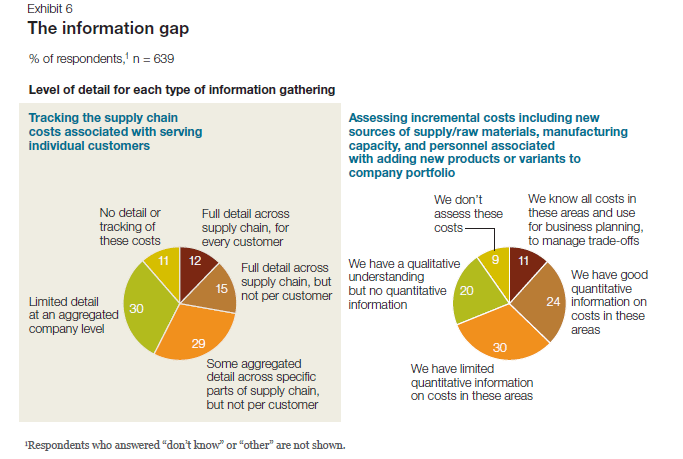The Butterfly Effect of Bad Data (Part 2)
Last time... Bad Data was revealed to be pervasive and costly In the first part of this two-part post, I wrote about the truly abysmal business outcomes our survey respondents reported in our "Poor Data Quality - Negative Business Outcomes" survey. Read about it here. In writing part 1, I was stunned by the following statistic: 95% of those suffering supply chain issues noted reduced or lost savings that might have been attained from better supply chain integration. The lost savings were large, with 15% reporting missed savings of up to 20%! In this post, I'll have a look at supply chains, and how passing bad data among participants harms participants and stakeholders, and how this can cause a "butterfly effect".
Supply Chains spread the social disease of bad data
A supply chain is a community of "consenting" organizations that pass data across and among themselves to facilitate business functions such as sales, purchase ordering, inventory management, order fulfillment, and the like. The intention is that executing these business functions properly will benefit the end consumer, and all the supply chain participants.In case the Human Social Disease Analogy is not clear...
Human social diseases spread like wildfire among communities of consenting participants. In my college days, the news that someone contracted a social disease was met with chuckles, winks, and a trip to the infirmary for a shot of penicillin. Once, a business analogy to those long-past days might have been learning that the 9-track tape you sent to a business partner had the wrong blocking factor, was encoded in ASCII instead of EBCDIC, or contained yesterday's transactions instead of today's. All of those problems were easily fixed. Just like getting a shot of penicillin. Today, we live in a different world. As we learned with AIDS, a social disease can have pervasive and devastating results for individuals and society. With a communicable disease, the inoculant has its "bad data" encoded in DNA. Where supply chains are concerned, the social disease inoculant is likely to be an XML-encoded transaction sent from one supply chain participant to another. In this case, the "bad transaction" information about the customer, product, quantity, price, terms, due date, or other critical information will simply be wrong, causing a ripple of negative consequences across the supply chain. That ripple is the Butterfly Effect.The BUTTERFLY EFFECT
The basis of the Butterfly Effect is that a small, apparently random input to an interconnected system (like a supply chain) may have a ripple effect, the ultimate impact of which cannot be reasonably anticipated. As the phrase was constructed by Philip Merilees in back in 1972...Does the flap of a butterfly’s wings in Brazil set off a tornado in Texas?According to Martin Christopher, in his 2005 E-Book "Logistics and Supply Chain Management", the butterfly can and will upset the supply chain.
Today's supply chains are underpinned by the exchange of information between all the entities and levels that comprise the complete end-to-end [supply chain] network... The so-called "Bullwhip" effect is the manifestation of the way that demand signals can be considerably distorted as a result of multiple steps in the chain. As a result of this distortion, the data that is used as input to planning and forecasting activities can be flawed and hence forecast accuracy is reduced and more costs are incurred. (Emphasis provided)
Supply Chains Have Learned that Bad Data is a Social Disease
Supply chains connect a network of organizations that collaborate to create and distribute a product to its consumers. Specifically, Investopedia defines a supply chain as:The network created amongst different companies producing, handling and/or distributing a specific product. Specifically, the supply chain encompasses the steps it takes to get a good or service from the supplier to the customerManaging the supply chain involves exchanges of data among participants. It is easy to see that exchanging bad data would disrupt the chain, adding cost, delay, and risk of ultimate delivery failure to the supply chain mix. With sufficient bad data, the value delivered by a managed supply chain would come at a higher cost and risk. Consider the graphic of supply chain management and the problems our survey respondents found in their experiences with supply chains and bad data. Click on the graphics to see them in full size.
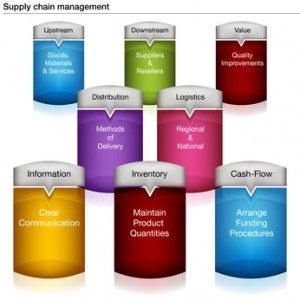
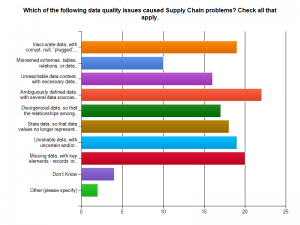
Bad data means ambiguously defined data, missing data, and inaccurate data with corrupt or plugged values. These issues lead the list of supply chain data problems found by our survey respondents.
Would you be pleased to purchase a new car delivered with parts that do not work or break because suppliers misinterpreted part specifications? Do you remember the old 1960 era Fords whose doors let snow inside because of their poor fit? Let's not pillory Ford, as GM and Chrysler had their own quality meltdowns too. Supply chain-derived quality issues like these kill revenues and harm consumers and brands.
Would you like to drive the automobile that contained safety components ordered with missing and corrupt data? What about that artificial knee replacement you were considering? Suppose the specifications for your medical device implant had been ambiguously defined and then misinterpreted. Ready to go ahead with that surgery? Bad data is a social disease, and it could make you suffer!
Bad Data is an Expensive Supply Chain Social Disease
Bad data is costing supply chain participants big money. As the graphic from our survey indicates, more than 20% of respondents to the Supply Chain survey segment thought that data quality problems added between 6% and 10 %. to the cost of operating their supply chain. Almost 16% said data quality problems added between 11% and 20% to supply chain operating costs. That is HUGE! The graphic following gives you survey results. Notice that 44% of the respondents could not monetize their supply chain data problems. That is a serious finding, in and of itself.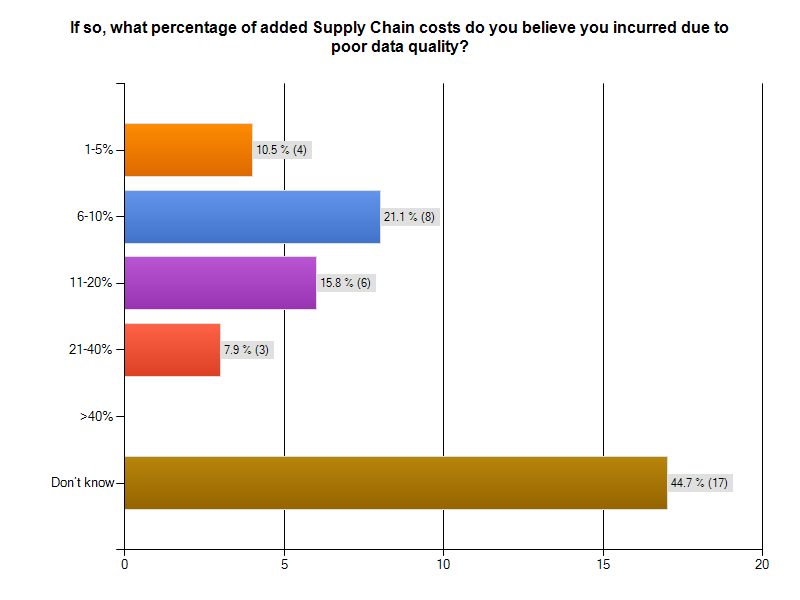
THOUGHT EXPERIMENT: CUT SUPPLY CHAIN MANAGEMENT COSTS by 20%
Over 15% of survey respondents with supply chain issues believed bad data added between 11% and 20% to the cost of operating their supply chain.Let's use 20% in our thought experiment, to yield a nice round number.
Understanding the total cost of managing a supply chain is a non-trivial exercise. Industry body The Supply Chain Council has defined The Supply Chain Operations Reference (SCOR®) model. According to that reference model, Supply Chain Management Costs include the costs to plan, source, and deliver products and services. The costs of making products and handling returns are captured in other aggregations.
For a manufacturing firm with a billion dollar revenue stream, the total costs of managing a supply chain will be around 20% of revenue, or $200,000,000 USD. Reducing this cost by 20% would mean an annual saving $40,000,000 USD. That would be a significant savings, for a data cleanup and quality sustenance investment of perhaps $3,000,000. The clean-up investment would be a one-time expense. If the $40,000,000 were a one time savings, the ROI would be 1,3333%.
But wait, it is better than that. The $40,000,000 savings recurs annually. The payback period is measured in months. The ROI is enormous. Having clean data pays big dividends!
If you think the one-time "get it right and keep it right" investment would be more like $10,000,000 USD, your payback period would still be measured in months, not years. Let's add a 20% additional cost or $2,000,000 USD in years 2-5 for maintenance and additional quality work. That means you would have spent $18,000,000 USD in 5 years to achieve a savings $200,000,000. That would be greater than a 10-times return on your money! Not too shabby an investment, and your partners and stakeholders would be saving money too. This scenario is really a win-win situation, right down the line to your customers.
The Corcardia Group believes that total supply chain costs for hospitals approach 50% of the hospital's operating budget. For a hospital with a $60,000,000 USD annual operating budget, a 20% savings means $12,000,000 USD would be freed for other uses, like curing patients and preventing illness.
Even Better...
For manufacturers, hospitals, and other supply chain participants, ridding themselves of bad data will produce still better returns. By cleaning up the data throughout the supply chain, it is likely that costs would go down while margins would improve. The product costs for participants could drop. Firms might realize an additional 5% cost savings from this as well. Their return is even better.What does the Supply Chain Community say about Data Quality?
A 2011 McKinsey & Company study entitled McKinsey on Supply Chain: Selected Publications, which you can download here, the publication "The Challenges Ahead for Supply Chains" by Trish Gyorey, Matt Jochim, and Sabina Norton goes right to the heart of a supply chain's dependency on data, and the weakness of current supply chain decision-making based on that data. According to the authors:Knowledge is power The results show a similar disconnection between data and decision making: companies seem to collect and use much less detailed information than our experience suggests is prudent in making astute supply chain decisions (Exhibit 6). For example, customer service is becoming a higher priority,and executives say their companies balance service and cost to serve effectively... Half of the executives say their companies have limited or no quantitative information about incremental costs for raw materials, manufacturing capacity, and personnel, and 41 percent do not track per-customer supply chain costs at any useful level of detail.Here is Exhibit 6 - a graphic from their study, referenced in the previous quote. Andrew White, writing about master data management for the Supply Chain Quarterly in its Q2-2013 issue, underscored the importance of data quality and consistency for supply chain participants.
... there is a growing emphasis among many organizations on knowing their customers' needs. More than this, organizations are seeking to influence the behavior of customers and prospects, guiding customers' purchasing decisions toward their own products and services and away from those of competitors. This change in focus is leading to a greater demand for and reliance on consistent data.White's take-away from this is...
...as companies' growing focus on collaboration with trading partners and their need to improve business outcomes, data consistency—especially between trading partners—is increasingly a prerequisite for improved and competitive supply chain performance. As data quality and consistency become increasingly important factors in supply chain performance, companies that want to catch up with the innovators will have to pay closer attention to master data management. That may require supply chain managers to change the way they think about and utilize data.Did everyone get that? Data Quality and Consistency are important factors in supply chain performance. You want your auto and your artificial knee joint to work properly and consistently, as their designers and builders intended. This means curing existing data social disease victims and preventing the recurrence and spread.
The Bottom Line
At this point, nearly 300 respondents have begun their surveys, and more than 200 have completed them. I urge those who have left their surveys in mid-course to complete them!Bad data is a social disease that harms supply chain participants and stakeholders. Do take a stand on wiping it out. The simplest first step is to make your experiences known to us by visiting the IBM InfoGovernance site and taking our "Poor Data Quality - Negative Business Outcomes" survey.
When you get to the question about participating in an interview, answer "YES"and give us real examples of problems, solutions attempted, success attained, and failures sustained. Only by publicizing the magnitude and pervasiveness of this social disease will we collectively stand a chance of achieving cure and prevention.
As a follow-up next step, work with us to survey your organization in a private study that parallels our public InfoGovernance study. The public study forms a excellent baseline for us to compare and contrast the specific data quality issues within your organization. Data Quality will not be attained and sustained until your management understands the depth and breadth of the problem and its cost to your organization's bottom line.
Contact me here and let us help you build the business case for eliminating the causes of bad data. Published by permission of Stuart Selip, Principal Consulting LLC
Bad Data is a Social Disease (Part 1)
Organizational bad data is a social disease easily passed to your business partners and stakeholders With 200 completed responses in our "Poor Data Quality - Negative Business Outcomes" survey, run in conjunction with The Robert Frances Group, the IBM InfoGovernance Community, and Chaordix, it is safe to say that bad data is a social disease that can spread easily and quickly. Merriam-Webster defines a social disease as
a disease (as tuberculosis) whose incidence is directly related to social and economic factorsOK, that definition works for the bad data social disease. In this case, the social and economic factors enabling and potentiating this disease include
- Business management failing to fund and support data governance initiatives
- IT management failing to sell the value of data quality to their business colleagues,
- Business partners failing to challenge and push-back when bad data is exchanged
- Financial analysts not downgrading firms that repeatedly refile 10-Ks due to bad data
- Customers not abandoning firms that err due to bad data quality and management
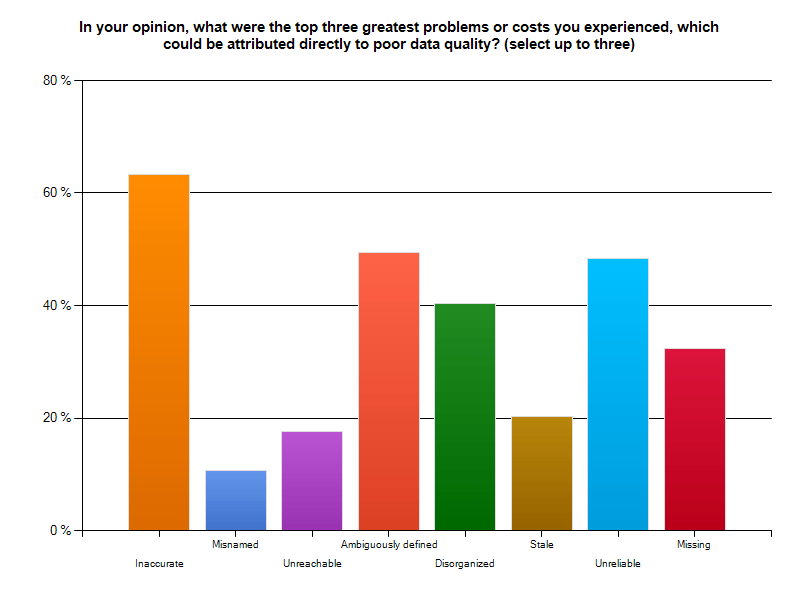 Social diseases negatively affect the sufferer, their partners, and the community around them. According to our respondents:
Social diseases negatively affect the sufferer, their partners, and the community around them. According to our respondents: 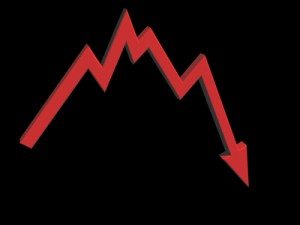
- 95% of those suffering supply chain issues noted reduced or lost savings that might have been attained from better supply chain integration.
- 72% reported customer data problems, and 71% of those respondents lost business because the didn't know their customer
- 71% of those suffering financial reporting problems said poor data quality cause them to reach and act upon erroneous conclusions based upon materially faulty revenues, expenses, and/or liabilities
- 66% missed the chance to accelerate receivables collection
- 49% reported operations problems from bad data, and 87% of those respondents suffered excess costs for business operations
- 27% reported strategic planning problems, with 75% of those indicating challenges with financial records, profits and losses of units, taxes paid, capital, true customer profiles, overhead allocations, marginal costs, shareholders, etc.)
What is in Part 2?
In next week's post, we'll examine some of our survey results specific to bad data and the supply chain. A successful supply chain requires sound internal data integration and equally sound data exchange and integration across chain participants.A network of willing participants exchanging data is fertile ground for spreading the social disease of business. Expect a thought experiment about wringing the bad data quality costs out of supply chain management, and see what some supply chain experts think about the dependency of effective supply chains on high quality data.The Bottom Line
Believe that bad data is a social disease and take a stand on wiping it out. The simplest first step is to make your experiences known to us by visiting the IBM InfoGovernance site and taking our "Poor Data Quality - Negative Business Outcomes" survey. When you get to the question about participating in an interview, answer "YES"and give us real examples of problems, solutions attempted, success attained, and failures sustained. Only by publicizing the magnitude and pervasiveness of this social disease will we collectively stand a chance of achieving cure and prevention. As a follow-up next step, work with us to survey your organization in a private study that parallels our public InfoGovernance study. The public study forms an excellent baseline for us to compare the specific data quality issues within your organization. You will not attain and sustain data quality until your management understands the depth and breadth of the problem and its cost to your organization's bottom line. Bad Data is a needless and costly social disease of business. Let's move forward swiftly and decisively to wipe it out! Published by permission of Stuart Selip, Principal Consulting LLCAs the consulting industry changes will you be the disrupter, not the disrupted?
Will you be the disrupter, not the disrupted? This is the question that came to mind as I read Consulting on the Cusp of Disruption, by Clayton M. Christensen, Dina Wang, and Derek van Bever, in the October 2013 issue of the Harvard Business Review (HBR). With an online subscription, you can read it here. Disruption means industry leaders are responding to the changes in customer demands and global economics by making fundamental changes in their approach to services, service delivery, engagement models, and the economic model on which their industry is based.  As an example of disruption, the HBR authors open by discussing the McKinsey & Company move to develop McKinsey Solutions, an offering that is not "human-capital based", but instead focuses on technology and analytics embedded at their client. This is a significant departure for a firm known for hiring the best and the brightest, to be tasked with delivering key insights and judgement. Especially when the judgment business was doing well. The authors make the point that the consulting industry has evolved over time.
As an example of disruption, the HBR authors open by discussing the McKinsey & Company move to develop McKinsey Solutions, an offering that is not "human-capital based", but instead focuses on technology and analytics embedded at their client. This is a significant departure for a firm known for hiring the best and the brightest, to be tasked with delivering key insights and judgement. Especially when the judgment business was doing well. The authors make the point that the consulting industry has evolved over time.
Generalists have become Functional Specialists Local Structures developed into Global Structures Tightly Structured Teams morphed into spider webs of Remote Specialists
 However, McKinsey Solutions was not evolutionary. In its way, it was a revolutionary breakthrough for McKinsey. While McKinsey Solutions' success meant additional revenue for the firm, and offered another means of remaining "Top of Mind" for the McKinsey Solutions' client, the move was really a first line of defense against disruption in the consulting industry. By enjoying "first mover advantage" McKinsey protected their already strong market position, and became the disrupter, not the disrupted.
However, McKinsey Solutions was not evolutionary. In its way, it was a revolutionary breakthrough for McKinsey. While McKinsey Solutions' success meant additional revenue for the firm, and offered another means of remaining "Top of Mind" for the McKinsey Solutions' client, the move was really a first line of defense against disruption in the consulting industry. By enjoying "first mover advantage" McKinsey protected their already strong market position, and became the disrupter, not the disrupted.
What is the classic pattern of disruption?
According to Christensen, et al,New competitors with new business models arrive; incumbents choose to ignore the new players or flee to higher-margin activities; a disrupter whose product was once barely good enough achieves a level of quality acceptable to the broad middle of the market, undermining the position of longtime leaders and often causing the "flip" to a new basis of competition.Cal Braunstein, CEO of The Robert Frances Group, believes that IT needs a disruptive agenda. In his research note, Cal references the US auto industry back in the happy days when the Model "T" completely disrupted non-production line operations of competitors. But when disruption results in a workable model with entrenched incumbents, the market once again becomes ripe for disruption. That is exactly what happened to the "Big 3" US automakers when Honda and Toyota entered the US market with better quality and service at a dramatically lower price point. Disruption struck again. Detroit never recovered. The City of Detroit itself is now bankrupt. Disruption has significant consequences.
Industry leaders may suffer most from disruption
In his work "The Innovator's Solution" HBR author Clayton M. Christensen addressed the problem of incumbents becoming vulnerable to disruption, writingThe disruption problem is worse for market leaders, according to Christensen.An organization's capabilities become its disabilities when disruption is afoot.
No challenge is more difficult for a market leader facing disruption than to turn and fight back - to disrupt itself before a competitor does... Success in self-disruption requires at least the following six elements: An autonomous business unit... Leaders who come from relevant "schools of experience"... A separate resource allocation process... Independent sales channels... A new profit model... Unwavering commitment by the CEO...So, it will be tough to disrupt yourself if you are big, set in your ways, and don't have the right CEO.
Being the disrupter, not the disrupted
The HBR authors characterized three forms of offering consulting, ranging from the traditional "Solution Shop" to "Value-added Process Businesses" and then to "Facilitated Networks". The spectrum ranges from delivering pronouncements from gifted but opaque expert practitioners charging by the hour through repeatable process delivery charging for delivered results to dynamic and configurable collections of experts linked by a business network layer. In my experience, the expert network form is the most flexible, least constrained, and most likely to deliver value at an exceptional price. It is at once the most disruptive, and presently the least likely form to be destabilized by other disruptive initiatives.The Bottom Line
 If you are in the consulting industry and you don't recognize that disruptive forces are changing the industry and your market's expectations as you read this, you will surely be the disrupted, not the disrupter. On the other hand, disrupters can be expected to provide a consulting service that will deliver much more value for a much lower price point. We are talking here of more than a simple process improvement 10% gain. It will be a quantum jump. Like McKinsey, that may come from embedding in some new solution that accelerates the consulting process and cuts costs. Now is the time to develop situation awareness. What are the small independent competitors doing? Yes, the little firms that you don't really think will invade your market and displace you. Watch them carefully, and learn before it is too late. Those readers who man those small, agile, and disruptive firms should ensure they understand their prospect's pain points and dissatisfaction with the status quo. As physician Sir William Olser famously said "Listen to your patient, he is telling you his diagnosis". Do it now! >
-
If you are in the consulting industry and you don't recognize that disruptive forces are changing the industry and your market's expectations as you read this, you will surely be the disrupted, not the disrupter. On the other hand, disrupters can be expected to provide a consulting service that will deliver much more value for a much lower price point. We are talking here of more than a simple process improvement 10% gain. It will be a quantum jump. Like McKinsey, that may come from embedding in some new solution that accelerates the consulting process and cuts costs. Now is the time to develop situation awareness. What are the small independent competitors doing? Yes, the little firms that you don't really think will invade your market and displace you. Watch them carefully, and learn before it is too late. Those readers who man those small, agile, and disruptive firms should ensure they understand their prospect's pain points and dissatisfaction with the status quo. As physician Sir William Olser famously said "Listen to your patient, he is telling you his diagnosis". Do it now! >
-Dell: The Privatization Advantage
Lead Analyst: Cal Braunstein
RFG Perspective: The privatization of Dell Inc. closes a number of chapters for the company and puts it more firmly on a different course. The Dell of yesterday was primarily a consumer company with a commercial business, both with a transactional model. The new Dell is planned to be a commercial-oriented company with an interest in the consumer space. The commercial side of Dell will attempt to be relationship driven while the consumer side will retain its transactional model. The company has some solid products, channels, market share, and financials that can carry the company through the transition. However, it will take years before the new model is firmly in place and adopted by its employees and channels and competitors will not be sitting idly by. IT executives should expect Dell to pull through this and therefore should take advantage of the Dell business model and transitional opportunities as they arise.
Shareholders of IT giant Dell approved a $24.9bn privatization takeover bid from company founder and CEO Michael Dell, Silver Lake Partners, banks and a loan from Microsoft Corp. It was a hard fought battle with many twists and turns but the ownership uncertainty is now resolved. What remains an open question is was it worth it? Will the company and Michael Dell be able to change the vendor's business model and succeed in the niche that he has carved out?
Dell's New Vision
After the buyout Michael Dell spoke to analysts about his five-point plan for the new Dell:
- Extend Dell's presence in the enterprise sector through investments in research and development as well as acquisitions. Dell's enterprise solutions market is already a $25 billion business and it grew nine percent last quarter – at a time competitors struggled. According to the CEO Dell is number one in servers in the Americas and AP, ships more terabytes of storage than any competitor, and completed 1,300 mainframe migrations to Dell servers. (Worldwide IDC says Hewlett-Packard Co. (HP) is still in first place for server shipments by a hair.)
- Expand sales coverage and push more solutions through the Partner Direct channel. Dell has more than 133,000 channel partners globally, with about 4,000 certified as Preferred or Premier. Partners drive a major share of Dell's business.
- Target emerging markets. While Dell does not break out revenue numbers by geography, APJ and BRIC (Brazil, Russia, India and China) saw minor gains over the past quarter year-over-year but China was flat and Russia sales dropped by 33 percent.
- Invest in the PC market as well as in tablets and virtual computing. The company will not manufacture phones but will sell mobile solutions in other mobility areas. Interestingly, he said Dell is a commercial seller more than in the consumer space now when it comes to end user computing. This is a big shift from the old Dell and puts them in the same camp as HP. The company appears to be structuring a full-service model for commercial enterprises.
- "Accelerate an enhanced customer experience." Michael Dell stipulates that Dell will serve its customers with a single-minded purpose and drive innovations that will help them be more productive, grow, and achieve their goals.
Strengths, Weaknesses, Challenges and Competition
With the uncertainty over, Dell can now fully focus on execution of plans that were in place prior to the initial stalled buyout attempt. Financially Dell has sufficient funds to address its business needs and operates with a strong positive cash flow. Brian Gladden, Dell's CFO, said Dell was able to generate $22 billion in cash flow over the past five years and conceded the new Dell debt load would be under $20 billion. This should give the company plenty of room to maneuver.
In the last five quarters Dell has spent $5 billion in acquisitions and since 2007 when Michael Dell returned as CEO, it has paid more than $13.7 billion on acquisitions. Gladden said Dell will aim to reduce its debt, invest in enhanced and innovative product and services development, and buy other companies. However, the acquisitions will be of a "more complimentary" type rather than some of the expensive, big-bang deals Dell has done in the past.
The challenge for Dell financially will be to grow the enterprise segments faster than the end user computing markets collapse. As can be noted in the chart below, the enterprise offerings are less than 40 percent of the revenues currently and while they are growing nicely, the end user market is losing speed at a more rapid rate in terms of dollars.
Source: Dell's 2Q FY14 Performance Review
Dell also has a strong set of enterprise products and services. The server business does well and the company has positioned itself well in the hyperscale data center solution space where it has a dominant share of custom server sales. Unfortunately, margins are not as robust in that space as other parts of the server market. Moreover, the custom server market is one that fulfills the needs of cloud service providers and Dell will have to contend with "white box" providers and lower prices and shrinking margins going forward. Networking is doing well too but storage remains a soft spot. After dropping out as an EMC Corp. channel partner and betting on its own acquired storage companies, Dell lost ground and still struggles in the non-DAS space to gain the momentum needed. The mid-range EqualLogic and higher-end Compellent solutions, while good, have stiff competition and need to up their game if Dell is to become a full-service provider.
Software is growing but the base is too small at the moment. Nonetheless, this will prove to be an important sector for Dell going forward. With major acquisitions (such as Boomi, KACE, Quest Software and SonicWALL) and the top leadership of John Swainson, who has an excellent record of growing software companies, Dell software is poised to be an integral part of the new enterprise strategy. Meanwhile, its Services Group appears to be making modest gains, although its Infrastructure, Cloud, and Security services are resonating with customers. Overall, though, this needs to change if Dell is to move upstream and build relationship sales. In that the company traditionally has been transaction oriented, moving to a relationship model will be one of its major transformational initiatives. This process could easily take up to a decade before it is fully locked in and units work well together.
Michael Dell also stated "we stand on the cusp of the next technological revolution. The forces of big data, cloud, mobile, and security are changing the way people live, businesses operate, and the world works – just as the PC did almost 30 years ago." The new strategy addresses that shift but the End User Computing unit still derives most of its revenues from desktops, thin clients, software and peripherals. About 40 percent comes from mobility offerings but Dell has been losing ground here. The company will need to shore that up in order to maintain its growth and margin objectives.
While Dell transforms itself, its competitors will not be sitting still. HP is in the midst of its own makeover, has good products and market share but still suffers from morale and other challenges caused by the upheavals over the last few years. IBM Corp. maintains its version of the full-service business model but will likely take on Dell in selected markets where it can still get decent margins. Cisco Systems Inc. has been taking market share from all the server vendors and will be an aggressive challenger over the next few years as well. Hitachi Data Systems (HDS), EMC, and NetApp Inc. along with a number of smaller players will also test Dell in the non-DAS (direct attached server) market segments. It remains to be seen if Dell can fend them off and grow its revenues and market share.
Summary
Michael Dell and the management team have major challenges ahead as they attempt to change the business model, re-orient people's mindsets, develop innovative, efficient and affordable solutions, and fend off competitors while they slowly back away from the consumer market. Dell wants to be the infrastructure provider for cloud providers and enterprises of all types – "the BASF inside" in every company. It still intends to do this by becoming the top vendor of choice for end-to-end IT solutions and services. As the company still has much work to do in creating a stronger customer relationship sales process, Dell will have to walk some fine lines while it figures out how to create the best practices for its new model. Privatization enables Dell to deal with these issues more easily without public scrutiny and sniping over margins, profits, revenues and strategies.
RFG POV: Dell will not be fading away in the foreseeable future. It may not be so evident in the consumer space but in the commercial markets privatization will allow it to push harder to remain or be one of the top three providers in each of the segments it plays in. The biggest unknown is its ability to convert to a relationship management model and provide a level of service that keeps clients wanting to spend more of their IT dollars with Dell and not the competition. IT executives should be confident that Dell will remain a reliable, long-term supplier of IT hardware, software and services. Therefore, where appropriate, IT executives should consider Dell for its short list of providers for infrastructure products and services, and increasingly for software solutions related to management of big data, cloud and mobility environments.
The Future of NAND Flash; the End of Hard Disk Drives?
Lead Analyst: Gary MacFadden
RFG POV: In the relatively short and fast-paced history of data storage, the buzz around NAND Flash has never been louder, the product innovation from manufacturers and solution providers never more electric. Thanks to mega-computing trends, including analytics, big data, cloud and mobile computing, along with software-defined storage and the consumerization of IT, the demand for faster, cheaper, more reliable, manageable, higher capacity and more compact Flash has never been greater. But how long will the party last?
In this modern era of computing, the art of dispensing predictions, uncovering trends and revealing futures is de rigueur. To quote that well-known trendsetter and fashionista, Cher, "In this business, it takes time to be really good – and by that time, you're obsolete." While meant for another industry, Cher's ruminations seem just as appropriate for the data storage space.
At a time when industry pundits and Flash solution insiders are predicting the end of mass data storage as we have known it for more than 50 years, namely the mechanical hard disk drive (HDD), storage futurists, engineers and computer scientists are paving the way for the next generation of storage beyond NAND Flash – even before Flash has had a chance to become a mature, trusted, reliable, highly available and ubiquitous enterprise class solution. Perhaps we should take a breath before we trumpet the end of the HDD era or proclaim NAND Flash as the data storage savior of the moment.
Short History of Flash
Flash has been commercially available since its invention and introduction by Toshiba in the late 1980s. NAND Flash is known for being at least an order of magnitude faster than HDDs and has no moving parts (it uses non-volatile memory or NVM) and therefore requires far less power. NAND Flash is found in billions of personal devices, from mobile phones, tablets, laptops, cameras and even thumb drives (USBs) and over the last decade it has become more powerful, compact and reliable as prices have dropped, making enterprise-class Flash deployments much more attractive.
At the same time, IOPS-hungry applications such as database queries, OLTP (online transaction processing) and analytics have pushed traditional HDDs to the limit of the technology. To maintain performance measured in IOPS or read/write speeds, enterprise IT shops have employed a number of HDD workarounds such as short stroking, thin provisioning and tiering. While HDDs can still meet the performance requirements of most enterprise-class applications, organizations pay a huge penalty in additional power consumption, data center real estate (it takes 10 or more high-performance HDDs to match the same performance of the slowest enterprise-class Flash or solid-state storage drive (SSD)) and additional administrator, storage and associated equipment costs.
Flash is becoming pervasive throughout the compute cycle. It is now found on DIMM (dual inline memory module) memory cards to help solve the in-memory data persistence problem and improve latency. There are Flash cache appliances that sit between the server and a traditional storage pool to help boost access times to data residing on HDDs as well as server-side Flash or SSDs, and all-Flash arrays that fit into the SAN (storage area network) storage fabric or can even replace smaller, sub-petabyte, HDD-based SANs altogether.
There are at least three different grades of Flash drives, starting with the top-performing, longest-lasting – and most expensive – SLC (single level cell) Flash, followed by MLC (multi-level cell), which doubles the amount of data or electrical charges per cell, and even TLC for triple. As Flash manufacturers continue to push the envelope on Flash drive capacity, the individual cells have gotten smaller; now they are below 20 nm (one nanometer is a billionth of a meter) in width, or tinier than a human virus at roughly 30-50 nm.
Each cell can only hold a finite amount of charges or writes and erasures (measured in TBW, or total bytes written) before its performance starts to degrade. This program/erase, or P/E, cycle for SSDs and Flash causes the drives to wear out because the oxide layer that stores its binary data degrades with every electrical charge. However, Flash management software that utilizes striping across drives, garbage collection and wear-leveling to distribute data evenly across the drive increases longevity.
Honey, I Shrunk the Flash!
As the cells get thinner, below 20 nm, more bit errors occur. New 3D architectures announced and discussed at FMS by a number of vendors hold the promise of replacing the traditional NAND Flash floating gate architecture. Samsung, for instance, announced the availability of its 3D V-NAND, which leverages a Charge Trap Flash (CTF) technology that replaces the traditional floating gate architecture to help prevent interference between neighboring cells and improve performance, capacity and longevity.
Samsung claims the V-NAND offers an "increase of a minimum of 2X to a maximum 10X higher reliability, but also twice the write performance over conventional 10nm-class floating gate NAND flash memory." If 3D Flash proves successful, it is possible that the cells can be shrunk to the sub-2nm size, which would be equivalent to the width of a double-helix DNA strand.
Enterprise Flash Futures and Beyond
Flash appears headed for use in every part of the server and storage fabric, from DIMM to server cache and storage cache and as a replacement for HDD across the board – perhaps even as an alternative to tape backup. The advantages of Flash are many, including higher performance, smaller data center footprint and reduced power, admin and storage management software costs.
As Flash prices continue to drop concomitant with capacity increases, reliability improvements and drive longevity – which today already exceeds the longevity of mechanical-based HDD drives for the vast number of applications – the argument for Flash, or tiers of Flash (SLC, MLC, TLC), replacing HDD is compelling. The big question for NAND Flash is not: when will all Tier 1 apps be running Flash at the server and storage layers; but rather: when will Tier 2 and even archived data be stored on all-Flash solutions?
Much of the answer resides in the growing demands for speed and data accessibility as business use cases evolve to take advantage of higher compute performance capabilities. The old adage that 90%-plus of data that is more than two weeks old rarely, if ever, gets accessed no longer applies. In the healthcare ecosystem, for example, longitudinal or historical electronic patient records now go back decades, and pharmaceutical companies are required to keep clinical trial data for 50 years or more.
Pharmacological data scientists, clinical informatics specialists, hospital administrators, health insurance actuaries and a growing number of physicians regularly plumb the depths of healthcare-related Big Data that is both newly created and perhaps 30 years or more in the making. Other industries, including banking, energy, government, legal, manufacturing, retail and telecom are all deriving value from historical data mixed with other data sources, including real-time streaming data and sentiment data.
All data may not be useful or meaningful, but that hasn't stopped business users from including all potentially valuable data in their searches and their queries. More data is apparently better, and faster is almost always preferred, especially for analytics, database and OLTP applications. Even backup windows shrink, and recovery times and other batch jobs often run much faster with Flash.
What Replaces DRAM and Flash?
Meanwhile, engineers and scientists are working hard on replacements for DRAM (dynamic random-access memory) and Flash, introducing MRAM (magneto resistive), PRAM (phase-change), SRAM (static) and RRAM – among others – to the compute lexicon. RRAM or ReRAM (resistive random-access memory) could replace DRAM and Flash, which both use electrical charges to store data. RRAM uses "resistance" to store each bit of information. According to wiseGEEK "The resistance is changed using voltage and, also being a non-volatile memory type, the data remain intact even when no energy is being applied. Each component involved in switching is located in between two electrodes and the features of the memory chip are sub-microscopic. Very small increments of power are needed to store data on RRAM."
According to Wikipedia, RRAM or ReRAM "has the potential to become the front runner among other non-volatile memories. Compared to PRAM, ReRAM operates at a faster timescale (switching time can be less than 10 ns), while compared to MRAM, it has a simpler, smaller cell structure (less than 8F² MIM stack). There is a type of vertical 1D1R (one diode, one resistive switching device) integration used for crossbar memory structure to reduce the unit cell size to 4F² (F is the feature dimension). Compared to flash memory and racetrack memory, a lower voltage is sufficient and hence it can be used in low power applications."
Then there's Atomic Storage which ostensibly is a nanotechnology that IBM scientists and others are working on today. The approach is to see if it is possible to store a bit of data on a single atom. To put that in perspective, a single grain of sand contains billions of atoms. IBM is also working on Racetrack memory which is a type of non-volatile memory that holds the promise of being able to store 100 times the capacity of current SSDs.
Flash Lives Everywhere! … for Now
Just as paper and computer tape drives continue to remain relevant and useful, HDD will remain in favor for certain applications, such as sequential processing workloads or when massive, multi-petabyte data capacity is required. And lest we forget, HDD manufacturers continue to improve the speed, density and cost equation for mechanical drives. Also, 90% of data storage manufactured today is still HDD, so it will take a while for Flash to outsell HDD and even for Flash management software to reach the level of sophistication found in traditional storage management solutions.
That said, there are Flash proponents that can't wait for the changeover to happen and don't want or need Flash to reach parity with HDD on features and functionality. One of the most talked about Keynote presentations at last August's Flash Memory Summit (FMS) was given by Facebook's Jason Taylor, Ph.D., Director of Infrastructure and Capacity Engineering and Analysis. Facebook and Dr. Taylor's point of view is: "We need WORM or Cold Flash. Make the worst Flash possible – just make it dense and cheap, long writes, low endurance and lower IOPS per TB are all ok."
Other presenters, including the CEO of Violin Memory, Don Basile, and CEO Scott Dietzen of Pure Storage, made relatively bold predictions about when Flash would take over the compute world. Basile showed a 2020 Predictions slide in his deck that stated: "All active data will be in memory." Basile anticipates "everything" (all data) will be in memory within 7 years (except for archive data on disk). Meanwhile, Dietzen is an articulate advocate for all-Flash storage solutions because "hybrids (arrays with Flash and HDD) don't disrupt performance. They run at about half the speed of all-Flash arrays on I/O-bound workloads." Dietzen also suggests that with compression and data deduplication capabilities, Flash has reached or dramatically improved on cost parity with spinning disk.
Bottom Line
NAND Flash has definitively demonstrated its value for mainstream enterprise performance-centric application workloads. When, how and if Flash replaces HDD as the dominant media in the data storage stack remains to be seen. Perhaps some new technology will leapfrog over Flash and signal its demise before it has time to really mature.
For now, HDD is not going anywhere, as it represents over $30 billion of new sales in the $50-billion-plus total storage market – not to mention the enormous investment that enterprises have in spinning storage media that will not be replaced overnight. But Flash is gaining, and users and their IOPS-intensive apps want faster, cheaper, more scalable and manageable alternatives to HDD.
RFG POV: At least for the next five to seven years, Flash and its adherents can celebrate the many benefits of Flash over HDD. IT executives should recognize that for the vast majority of performance-centric workloads, Flash is much faster, lasts longer and costs less than traditional spinning disk storage. And Flash vendors already have their sights set on Tier 2 apps, such as email, and Tier 3 archival applications. Fast, reliable and inexpensive is tough to beat and for now Flash is the future.



